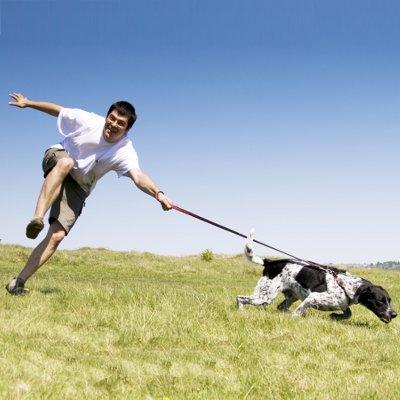Have you ever heard or said, "My dog knows how to sit. He just doesn't want to do it right now," while at the park? Meanwhile kids are screaming at a blaring ice cream truck, a Chihuahua is yapping at them or someone has just pulled out doggy gold: a.k.a. a tennis ball. Still, most owners don't realize the enormity of what they're asking from their dogs because we don't live in a dog's world. We often ask too much too soon. New places, new smells and situations are all incredibly distracting to your dog. This is especially true for some breeds from the hound and terrier. By human standards, all dogs have an incredible sense of smell. These breeds are the Olympians of scent. There is so much information coming in from their noses that it may be challenging for them to give you their full attention.
 Most dogs are not really "stubborn"; they're distracted. If your goal is reliable obedience, you're going to need to build a good foundation. You'll need some techniques for hooking and holding your dog's attention.
Most dogs are not really "stubborn"; they're distracted. If your goal is reliable obedience, you're going to need to build a good foundation. You'll need some techniques for hooking and holding your dog's attention.
Slow and Easy Does It Every Time When training your dog, start in an easy environment where he can fully concentrate. Early success is very important in teaching behaviors. That way, your dog gets rewarded quickly and begins to love training sessions. Once your pup can do a command 9 out of 10 times, you can move on to a different environment with some distractions. Be mindful of your dog's distraction threshold. The neighboring kids may not be a great distraction if they're 50 yards away; but they may absorb your dog's full attention at 50 ft. away. If you find yourself getting frustrated and your dog is not listening, then you have too much distraction and need to take a step back.
Dogs don't generalize well. For you and me, riding a bike is riding a bike, whether you're in Downtown Knoxville or on Mount Kilimanjaro. For dogs however, learning to sit in two different environments is akin to learning to drive on the opposite side of the road; some things stay the same, but there are just as many (if not more) things that are totally different. Dogs need to practice training behaviors in varying conditions and situations. Your dog may know how to sit while you are right in front of him, but if you ask him to sit while you are sitting in a chair, or laying down on the floor, will he do it?
Finding the Right Motivation
In the end, a huge part of your success in training your dog will be determined by whether or not you present the right motivation (read "bribe"). If you're expecting a greater amount of concentration and effort, you may need to switch from those stale doggy biscuits to some yummy cheese or hot dog chunks. The reward must equal or outweigh all other distractions.
Dogs truly are individuals. You may have one dog that loves tennis balls and will do anything for a quick game of fetch, and another that will look at you funny when you throw a ball and expect some sort of reaction. Dedicate some time for experimentation to figure out the denominations of your newfound doggy currency.
Start by rewarding your dog for every instance of the correct behavior. With time and greater reliability, you can begin to vary the frequency of rewards, or string together multiple behaviors into a sequence between rewards. If your dog gets stuck, go back to something easy and take a break. About 15 minutes is all many dogs can handle at first. Your dog will build endurance with time, if you find it necessary. Try to end your session on a positive note with a behavior you can reward.
Patience
Be patient and listen to your dog. Dogs communicate an enormous amount through body language and often look at our gestures for cues. Are you communicating correctly with your pup? Always pair a clear and distinct gesture with each new command. You may need to make funny sounds to get your dog's attention (who cares what the neighbors think, right?). Quick and high-pitched (though not piercing or threatening) sounds can serve as an interrupt. Just as they begin to get distracted, you can interrupt that moment and bring your dog's focus back at you. Dogs are very attuned to our emotions and can feel when we get frustrated. When training is no longer fun and rewarding, your dog will not want to work for you. Much of dog training is really just training ourselves. Sometimes a deep breath and a change in your attitude can have a big impact. Not only will your work pay off in a great dog and a healthy bond, but you'll develop a new level of patience and sensitivity to the situations you find yourself in. It's definitely worth the work!
Poisoned Cues
Maybe you have one of those "friends" that only ever calls you when they need something. You may bristle at the thought of picking up their calls. Dogs too are amazing, associative learners. If a particular behavior always begets a negative consequence, then your dog may not want to do it anymore. Don't be the owner that only ever uses the "come" command when it's time for your dog to go in his crate or leave the dog park. You might be sorely disappointed by having "poisoned" the cue. Instead, periodically call your dog just for a quick treat or play session. Your dog should think you're the most fun thing that walks on two legs, makes strange sounds and dispenses yummy treats.
Training a dog, "stubborn" or not, should never feel like a power struggle. In other words, the goal is a relationship that is mutually beneficial. Just take it slow, work the same behavior in several environments, find the right motivation and be patient. Oh yeah . . . and avoid "poisoning" any cues!






